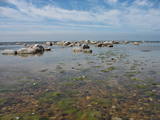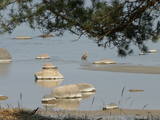| Nr | Nosaukums | Apraksts |
|---|---|---|
|
„Rožlejas” atrodas Tukuma novada Džūkstes pagastā, kur Austrumkursas augstiene mijas ar Tīreļu līdzenumu. 1989. gadā saimniekošanu uzsāka tagadējā saimnieka - Jāņa Ukšes vecāki. Tika izveidota naturālā saimniecība, kur sākotnēji audzēja cukurbietes, bet vēlāk – kviešus. Divdesmit piecu gadu laikā, pārdomātas saimniekošanas rezultātā, „Rožlejas” ir izveidojušās par vienu no lielākajām graudaugu saimniecībām Latvijas rietumdaļā. Saimnieki aktīvi startējuši dažādos ES projektos. Iepirkta mūsdienīga tehnika, uzbūvēti graudu un tehnikas glabāšanas angāri. Saimniecības specializācija ir graudi (ziemas mieži, ziemas kvieši), kas šobrīd tiek audzēti ~ 1200 ha platībā. |
||
|
Kafejnīca piedāvā svaigi gatavotus mājas ēdienus. "Cafe 21 & Putnu Dārzs" izīrē telpas banketu, svinību,mielastu, furšetu un semināru rīkošanai. Veic ēdienu piegādi un izbraukumu servisu. |
||
|
Naukšēnu vīna darītava ir bioloģiskā saimniecība, kurā dara sidru no Paradīzes āboliem. Vēsture Āboli Sidri Apmeklētājiem Kur iegādāties |
||
|
„Vitrupe - Tūja” - nozīmīga teritorija rifu aizsardzībai. Teritorija atrodas iepretim Salacgrīvas novadam, tās platība ir 3577 ha. Teritorija ietver dabas lieguma „Vidzemes akmeņainā jūrmala” jūras daļu.
|
||
|
Vides objekts ”SUITU TIKŠANĀS VIETA” Alsungā tapis Jūrkalnes starptautiskā mākslas plenēra ietvaros. Tā idejas autors ir Igo. Vides objektu veidojis tēlnieks Ivars Miķelsons kopā ar Didzi Grodzu un Juri Kraftu. |
||
|
Dzērieni no Kurzemē augušiem un pašu lasītiem augļiem un ogām. 100% roku darbs. Vēsture Āboli Apmeklētājiem Kur iegādāties |
||
|
Izteiksmīga reljefa forma – ar mežu daļēji apaudzis paugurs, kas virs tuvākās apkārtnes paceļas par ~ 40 m ar plašām skatu perspektīvām. Par pilskalna esamību liecina līdz mūsdienām saglabājies grāvis un aizsargvaļņa atliekas. Domājams, ka 10. gs. pilskalnu apdzīvojušas latgaļu ciltis. Pilskalnā var uzkāpt un aplūkot apkārtnes ainavas. |
||
|
This cycling route will take you from Riga along the West coast of the Baltic Sea of Latvia and Lithuania. On the way the route passes the sea resort Jurmala with 19th century wooden archicture, the picturesque Abava river valley, geologicaly interesting steep banks of Jūrkalne, historically exiting city of Liepaja with great ambience and charming Kuldiga with the widest waterfall in Europe. In Lithuania the route goes through Palanga where Amber Museum is located and culminates at the National Park of the Curonian Spit with 60m high sand dune. |
||
|
Nīcas „Agri” atrodas 1,5 km dienvidos no Nīcas ciema centra. Regīna Kalniņa apmeklētājiem piedāvā iepazīt pašas šūto Nīcas un Pērkones un arī Rucavas tautas tērpu kolekciju, stāstot par to, kā tie tapuši, kā jāģērbj un jāvalkā. Īpaši unikāls no tiem ir Pērkones tautas tērps. Mantojuma skapī, kurā glabājās tautas tērpi, atrodami arī pašas darināti dvieļi, palagi un segas. Amatniece ada cimdus un zeķes, kuri šeit ilgi nepaliek, jo „aizceļo” uz dažādām pasaules valstīm. To paraugi apskatāmi biezos fotoalbumos. Apskatāmas arī stelles. Apmeklētāji var iepazīt aušanas un adīšanas procesu, kā arī noklausīties aizraujošā stāstā par Lejaskurzemes novadu tautas tērpu un rakstu tradīcijām. |
||
|
Dārzkopības institūts ir vadošais augļkopības un dārzeņkopības pētniecības centrs Latvijā, kas ne tikai nodarbojas ar Baltijas agroklimatiskajiem apstākļiem piemērotu augu sugu selekciju un introdukciju, bet arī ražo ar augstu uzturvērtību, šķiedrvielām bagātus pārtikas produktus no institūta dārzos izaudzētā. Dobeles viesiem pavasara ziedoņa laikā ir iespēja izstaigāt takas vienā no lielākajiem ceriņu dārziem Eiropā, kurā aug 240 dažādi ceriņi. Maijā/jūnijā Dārzkopības institūta dārza viesi var priecāties par aprikožu, ķiršu, plūmju, ābeļu, bumbieru, cidoniju ziedu kupenām. |
||
|
„Rīgas jūras līča rietumu piekraste” - nozīmīga patvēruma un barošanās vieta lielam skaitam migrējošo putnu sugu visa gada garumā. Biežāk sastopamās aizsargājamās putnu sugas – brūnkakla un melnkakla gārgale, jūrmalas dižpīle, kākaulis, tumšā pīle un mazais ķīris, teritorija ir nozīmīga arī rifu aizsardzībai. Teritorija atrodas iepretim Dundagas, Rojas un Engures novadam, kā arī Jūrmalas pilsētai, tās platība ir 132 173 ha. Teritorija ietver dabas parka „Engure” un Ķemeru nacionālā parka jūras daļu.
|
||
|
The tour introduces visitors to varied landscapes, local traditions and historic sites. Travellers are usually surprised that such a small territory holds so many contrasts. Riga offers a medieval Old Town and elegant Art Nouveau district, then comes Sigulda with three castles on the high banks of the Gauja river valley. Saaremaa island is a pleasure to drive around with good quality, quiet roads, windmills, medieval churhes and ethnographic villages. Tallinn has its walled Old Town while Lahemaa national park has an almost mystical landscape There is also elegant Palmse Manor. The tour goes through sleepy villages in eastern Latvia with distinctive pottery, ancient culinary traditions, and the Catholic pilgrimage site of Aglona. Vilnius' historic centre has distinctive baroque churches. The massive sand dunes of the Curonian Spit and Nida with its characteristic blue framed windows are among Lithuania's most attractive sights. Trakai has its picturesque medieval castle on the lake as well as the small Karaitis ethnic comunity with their unique traditions and food. Port towns Klaipeda and Liepaja have both developed into bustling modern cities with lively cafe culture. |
||
|
Tagad redzamās muižas pils (klasicisma stils) pirmsākumi meklējami 1784. g. Vēlākos laikos to pārbūvēja par divstāvu ēku, kurai ir četru kolonnu portiks tās centrālajā daļā. Jauns pagrieziens muižas attīstībā uzsākās 1993. g., kad uzsākta ēku restaurācija. Šobrīd muižas kompleksā atrodas Grašu bērnu ciemats, bet kungu mājā – viesnīca. |
||
|
Elkas kalna saimniecība atrodas ainaviskā Elkas kalna virsotnē. Saimniecībā tiek audzētas zāļu tējas, izgatavoti ziedūdeņi no Elkas kalna pļavās ievāktiem un dārzā audzētiem augiem, tecinātas bērzu sulas, kuras saldētas glabājas līdz pat vasarai, gatavoti ievārījumi un citi veselīgi gardumi. Amatas pagasta stāstnieku pavadībā iespēja doties ekskursijā-pārgājienā uz Gaujas sākumu Elkas kalnā vai augu ekspedīcijā, kuras laikā saimniece iepazīstina apmeklētājus ar dažādām zāļu tējām, palīdz sagatavot savu īpašo tēju maisījumu vai ziepes. Degustācijai - zāļu tēja, bērz sula, ievārījumi, pašu gatavotu ķirbju miltu izstrādājumi. Piedāvājumā no Elkas kalna saimniecībā audzētiem dārzeņiem, dīķī nomakšķerētām zivīm vai gaļas gatavotas maltītes, kuras pagatavojamas arī ārā uz dzīvas uguns. Iespēja nakšņot teltī. Pieejama terase nelielām svinībām. |
||
|
Ļoti skaists un ainavisks etnogrāfiskais ciems Balošas (Baluošas) ezera ziemeļu krastā, netālu no diviem iepriekš minētajiem ciemiem. Te apskatāmas interesantas un skaistas koka ēkas, kas celtas no guļbaļķiem, ar niedru vai lubiņu jumtiem un izrotātas ar dažāda veida dekoratīvajiem elementiem. Pirmo reizi rakstos Šumini minēti 1784. g. Savu vārdu ciems ieguva no kādreiz dzīvojošas ģimenes uzvārda. Kā interesantākā ir jāpiemin sena klēts. |
||
|
Atrodas Nīcā, TIC ēkas otrajā stāvā.Šeit apskatāmas > gadsimtu vecs Nīcas tautastērps ar tā neatņemamām sastāvdaļam - brunčiem, ņieburu, vamzi un austenēm. Nīcas pūralādē noglabāti vietējo rokdarbnieču darbi, kas turpina šejienes amatu tradīcijas. Apmeklētāji var iepazīt Nīcas segas, lakatus, galdautus un citas saimniecībā noderīgas lietas, kā arī cimdu un zeķu pārus. Ja interesē etnogrāfiskas un ar novadpētniecību saistītas tematikas – šī ir vieta, kas noteikti jāapmeklē. |
||
|
Šis ir viens no 6 ceļojuma maršrutiem sērijā "Baudi laukus!", un tas aicina apmeklēt Lauku Labumus – visdažādāko veidu un nozaru saimniecības un uzņēmumus, kas atvērti apmeklētājiem, piedāvā ekskursijas, nogaršot, apskatīt un iegādāties savus ražojumus. Tur apskatāmi mājdzīvnieki, mūsdienīgas lauku saimniecības, amatnieku darbnīcas, iegādājami lauku produkti – maize, medus, mājas vīns un alus, siers, ogas, augļi, zivis, gaļa, dārzeņi, tējas un citi laukos audzēti labumi. Pa ceļam iespējams ieturēt pusdienas lauku krodziņos. |
||
|
Mājas restorāns mājīgā, autentiskā lauku vidē, kur tiek pasniegti lauku ēdieni, uz galda celtas svaigas jūras veltes, kuras atceļojušas no Francijas, Spānijas vai Norvēģijas, kā arī vietējās, pašu saimnieku kūpinātas zivis. Ēdienkarte tiek radīta katru dienu no jauna, kas ikdienā ļauj piedāvāt svaigus produktus.
|
||
|
Valkas novadā, Pedelē, atrodas saimniecība "Kalnbundas". Tajā pieejamas izjādes un pārgājieni ar zirgiem, zirgu pajūga noma (ziemā kamanas), gunskura vietas un telšu vietas |
||

























